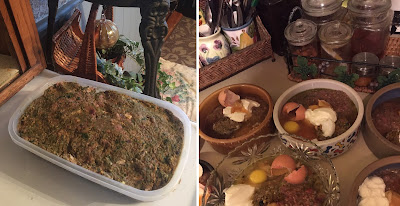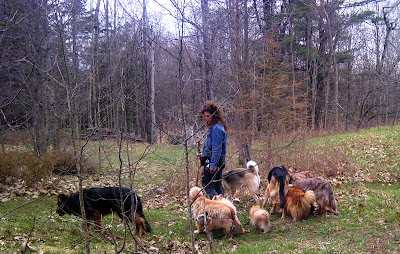Slippery Elm Bark - Herbs for Dogs and Cats
★ 4 min read
In this article:
- What is Slippery Elm Bark?
- Health Benefits of Slippery Elm Bark
- Slippery Elm Can Help Remedy Inflammatory Issues and Disease
- Cancer
- Gut and Gastrointestinal Issues
- Oral Health Issues
- Respiratory Issues
- Skin Issues
- Urinary Tract Issues
- How to Use Slippery Elm Bark
- Ingested Use
- Topical Use
- Poultice Recipe
- How to Administer Slippery Elm Bark Powder
- Slippery Elm Bark Dosage to Treat Diarrhea
- General Dosing Guidelines by Body Weight
- Slippery Elm Bark Syrup Recipe
- Cautions
- Side Effects
- Drug Interactions
1.0 What is Slippery Elm Bark
Slippery elm bark (Ulmus fulva) is the inner bark of the slippery elm tree. The inner bark has been used as a demulcent (soothing) herbal remedy for centuries. The inner bark is stripped from the outer bark, air dried and used in various forms to heal ailments.
Slippery elm bark contains astringent tannins and mucilage. When mixed with fluid,
slippery elm bark turns into a healing, soothing, lubricating gel. The gel works to coat and soothe emucosal tissues in the mouth, throat,
stomach, and intestines. It also contains antioxidants that help relieve
inflammation.
Your dog and cat's mucosal tissues can become inflamed, swollen and irritated as a result of: dietary indiscretions, bacterial and viral infections, trauma and illness. Slippery elm is an excellent herbal remedy to help treat this type of inflammation, swelling and irritation.
Slippery elm bark is effective for coughs, sore throats, inflamed gums, diarrhea and a variety of stomach issues and conditions. It's also an effective topical remedy to help treat oral abscess, skin inflammation, burns, minor wounds. and urinary tract issues.
This wonderful bark also triggers stimulation of nerve
endings in the gastrointestinal tract, promoting increased mucus secretion. This
helps protect the upper and lower GI tract from excess acidity and helps prevent the formation of ulcers.
Slippery elm bark is safe for puppies and kittens and dogs and cats of all ages, and has a sweet scent similar to caramel.
2.0 Health Benefits of Slippery Elm Bark
Slippery elm bark reduces:
- Inflammation
- Swelling
- Irritation
Helps heal damaged tissue:
- Mucosal tissue
- Skin tissues
Helps fight infection:
- Bacterial
- Fungal
- Viral
3.0 Slippery Elm Can Help Treat Inflammatory Issues and Disease
a partial list:
3.1 Cancer
- Colon cancer
- Liver cancer
- Mammary cancer
- Ovarian cancer
- Uterine cancer
3.2 Gut and Gastrointestinal Issues
- Acid reflux
- More on acid reflux here.
- Anal fissures
- Anal gland issues
- Candida
- Chronic indigestion resulting in malnutrition
- Colitis
- Constipation
- Crohn's Disease
- Diarrhea
- More on diarrhea here.
- Gastroenteritis
- Irritable bowel syndrome (IBS)
- Leaky Gut
- Ulcers
3.3 Oral Health Issues
Apply topically to help treat:
- Inflamed gums
- Oral abscess
More on oral health issues here.
3.4 Respiratory Issues
- Herbal cough syrup recipe for dogs and cats:
- Go to this article
- Asthma
- Cough
- Hoarse vocal cords from excessive barking, trauma, or illness
- Kennel cough
- Sore throat
3.5 Skin issues
For topical use on:
- Burns
- Infection
- Sun burn
- Ulcers
- Wounds
3.6 Urinary Tract Issues
4.1 Slippery Elm Bark, Ingested Use
Slippery elm bark can be used in various forms.
- Capsule
- Powder
- Syrup (see the recipe further below)
- Tea
- Tincture
4.2 Slippery Elm Bark, Topical Use
4.2.1 Slippery Elm Bark Poultice Recipe
You'll Need:
- Slippery elm bark powder.
- Liquid:
- Colloidal silver.
- Honey, raw, unpasteurized, pure.
- Distilled water.
- Small glass bowl.
Preparation:
- Place the desired amount of slippery elm bark powder in the glass bowl.
- If the area to be treated is small use 1/2 tsp to 1 tsp of powder.
- If the area to be treated is larger increase the amount of powder to suit.
- Add enough liquid to make a thick paste, mix well.
Instructions for Use:
- Apply the poultice to problem area 1x to 3x per day as needed.
- Make a new batch of poultice daily.
Learn About Colloidal Silver
- Health benefits.
- Uses.
- Cautions.
- etc.
Go to this article.
4.3 How To Administer Slippery Elm Bark Powder
To administer slippery elm bark powder to your dog or cat, sprinkle onto or mix into:
- Food.
- Short cooked broth.
- Bone broth.
4.4 Slippery Elm Bark Dosage To Treat Diarrhea
If your cat or dog is experiencing diarrhea, the dosage is:
- 1/2 tsp of slippery elm bark powder for every 10 lbs of body weight.
- Dose 2 times up to 4 times per day.
Learn more about:
- Types of diarrhea.
- Common causes.
- Symptoms.
- Foods to avoid.
- Foods to help treat diarrhea.
- Herbs to help treat diarrhea.
Go to this article.
4.5 General Dosing Guidelines
To zoom-in, click on the chart below:
The chart above provides dosing guidelines based on your dog or cat's body weight and type of slippery elm bark used:
- Capsule
- Powder
- Tea
- Tincture
5.0 Slippery Elm Bark Syrup Recipe
The active constituents in slippery elm bark increase when mixed with fluid and heated in the making of the syrup.
You'll Need
- Slippery elm bark powder
- Spring water or filtered water
- Stainless steel saucepan
Preparation
- Place 1 tsp to slippery elm bark powder in your saucepan.
- Add one cup of water.
- Stir the powder and water.
- Turn the heat and bring the mixture to a boil, while you stir the mixture.
- Once the mixture reaches the boiling point, turn the heat down and let the mixture simmer for 2 to 3 minutes.
- Then remove the saucepan from the heat and allow the resulting syrup to cool to room temperature.
- The slippery elm syrup is ready to use.
Instructions for Use
- Administer the slippery elm syrup to your dog or cat 2 times up to 4 times per day as needed.
- The syrup can be dosed directly into your dog or cat's mouth, mixed into food, broth or offered on the palm of your hand or plate.
- Use for as long as needed.
Storage
- Store the syrup in the refrigerator.
- Make a new batch every day or two until no longer needed.
Dosing Guideline:
- 1 teaspoon, 2x up to 4x per day
Small Dogs:
- 1 teaspoon, 2x up to 4x per day
Medium Dogs:
- 1 to 2 tbs, 2x to 4x per day
Large Dogs:
- 3 to 4 tbs, 2x to 4x per day
6. Cautions
- Dose at least 30 minutes away from conventional medications.
7. Side Effects
None unless your dog or cat is hypersensitive (intolerant or allergic) to slippery elm trees, in which case do not use slippery elm bark powder.8. Drug Interactions
Slippery elm contains a soft fibre
called mucilage which can decrease how much medicine the body absorbs.
To prevent interaction, administer slippery elm bark at least one hour after conventional medications.
Holistic Diet, Nutrition, Wellness Services Tailored to Your Individual Dog and Cat
For information about my holistic diet, nutrition, wellness services visit my:
Maintain good health | Address acute and chronic health issues | Pre and post surgery support and recovery
My holistic wellness services are available worldwide via video consultation.
🌎 USA | Canada | UK | Europe | Australia | New Zealand | Asia | South and Central America | Africa | UAE
📱 FaceTime | Facebook | Skype | WhatsApp
Holistic Behavioral Services For Your Dog
For information about my holistic behavioral services visit my:
For dogs of all ages, sizes and breeds
My holistic behavioral services are available locally in-person and worldwide via video session.
🌎 USA | Canada | UK | Europe | Australia | New Zealand | Asia | South and Central America | Africa | UAE
📱 FaceTime | Facebook | Skype | WhatsApp
Affiliations to Companies
✓ None.
✓ I don't sell food or supplements.
✓ I'm not aligned with any companies.
✓ None.
✓ I don't sell food or supplements.
✓ I'm not aligned with any companies.
Article and graphics by Karen Rosenfeld


















